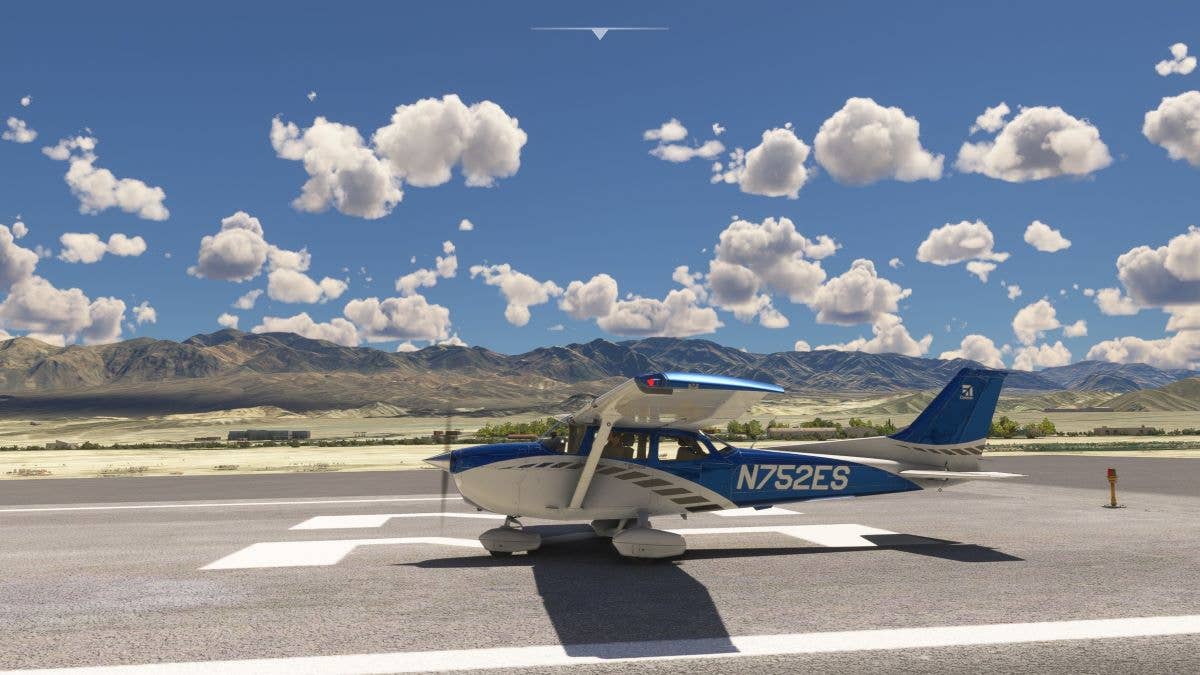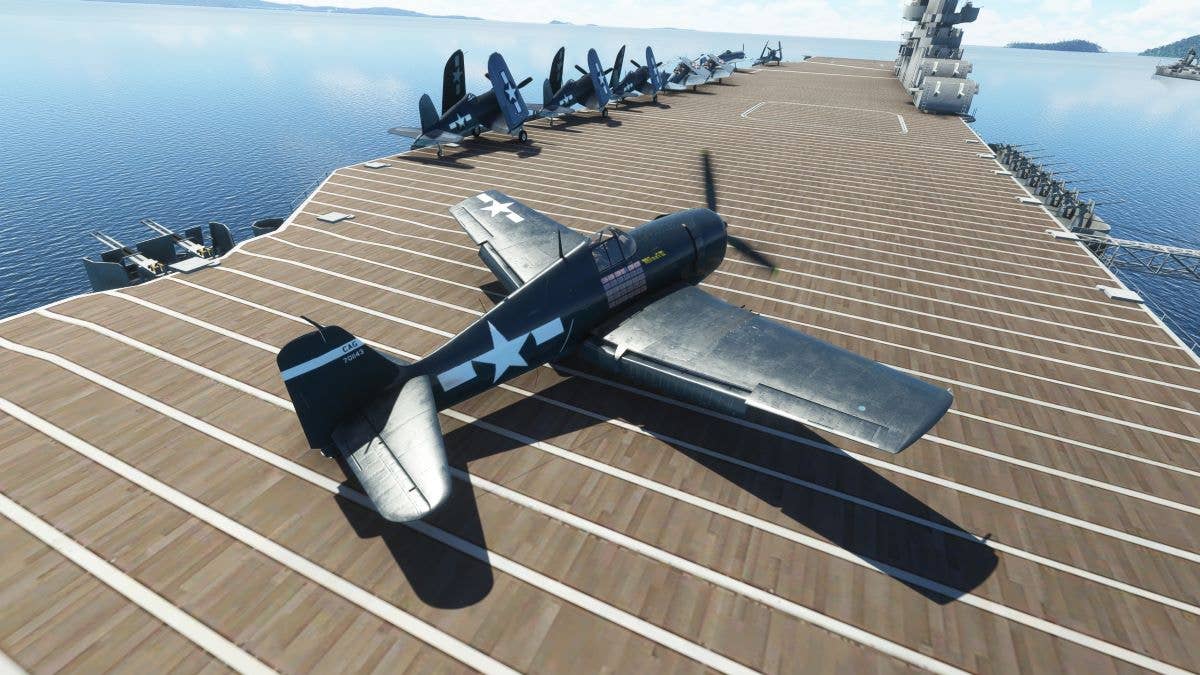The Rugged, Sleek Legacy of the Beechcraft ‘Staggerwing’
Ride along on a Microsoft Flight Simulator journey through history in a Beechcraft Model 17.

[Image courtesy Patrick Chovanec]
The Beechcraft Model 17 "Staggerwing" cuts an unusually sleek profile through aviation history. Today in Microsoft Flight Simulator, I’ll be flying the Model 17, widely regarded as one of the world’s most enviable private airplanes.
Walter Beech was born in 1891 in Pulaski, Tennessee, and flew in the U.S. Army during World War I. After the war, he joined Swallow Airplane Co. as a test pilot. In 1924, Beech joined fellow airplane designers Lloyd Stearman and Clyde Cessna—both of whom later gave their names to famous aircraft—to form the Travel Air Manufacturing Co. in Wichita, Kansas. The small company hired a 21-year-old office manager and bookkeeper named Olive Ann Mellor. She proved to have an extremely good head for business. Walter and Olive Ann began a low-key romance and were eventually married in 1930.
In 1929, Travel Air was acquired by Curtiss-Wright. Olive Ann urged Walter, frustrated with his new corporate job, to follow his dream and start his own airplane design company. She told him, “If you want something, you can do it.” They rented a factory from Beech’s friend and rival Cessna in Wichita. The first airplane they designed and produced, starting in 1933, was the Model 17 (because the last aircraft produced by Travel Air was Model 16).
I’m here at the Beech Factory Airport (KBEC) on the east side of Wichita, where modern-day Beechcraft are still produced, to check out that airplane, which was intended as a high-class, high-powered private option for wealthy business executives—the Gulfstream of its day.
The most obvious and eye-catching feature of the Model 17 is the fact that its upper wing is set back from its lower wing—the opposite of most biplane designs. This “negative stagger wing” gave rise to it popularly being dubbed the “Staggerwing,” a nickname Beech didn’t particularly like, preferring to call it the “Beechcraft.”
Some major advantages of the negative stagger wing were improved stalling characteristics and reduced interference drag between the two wings. But another was better forward visibility, which in conventional biplanes was often blocked by the top wing.
Like many aircraft of its day, the Model 17 was constructed of fabric covering a steel tube frame. However, its skin was faired (smoothed to minimize drag) with wooden formers. The high-end manufacturing process was complex and time-consuming.
A variety of radial engines were used, ranging from 350 to 690 hp. This model, the D17S, features a 450-hp Pratt & Whitney Wasp Junior, the same used (in twin configuration) to power the Lockheed L-10 Electra and Grumman Goose.
To further minimize drag and increase speed, the landing gear is fully automated and retractable—something that was still an innovation for new all-metal airliners, much less a private airplane.
The Model 17 also featured flaps—another relatively new innovation at the time—on the lower wing for sufficient lift at slower landing speeds and nearly full-length ailerons on the top wing for effective control. The cabin was spacious with comfortable upholstery trimmed in leather and mohair, suitable for its high-end target market.
There is only one yoke, which can be switched between the left and right seats. The throttle, mixture, and variable pitch prop controls are all located in the center of the panel below the flaps switch. Note that the main instruments in front of the pilot are arrayed in a recognizably modern “six-pack” configuration before this became standard.
Time to rev up the engine and find out how this package handles in the air. Perhaps a little odd looking on the ground, the Staggerwing shows its true streamlined prowess once it takes off and raises its gear.
The Staggerwing has a cruise speed of 202 mph (175 knots), not that far short of a fighter for its era. I got it up to its maximum speed of 212 mph on a flat straightaway.
The forward visibility is generally excellent, because of the negative stagger wing, but I did find the three structural braces and position of the overhead compass in the cockpit do make it a bit difficult to see the runway clearly on approach.
Nevertheless, I did end up safely on the ground and found it easier (at least in the sim) than many tailwheel aircraft to keep straight and avoid a ground loop on landing.
The first Beechcraft was one sleek machine. But at a price tag of between $14,000 and $17,000 (the equivalent of $320,000 to $390,000 today), aimed at a high-end customer, it was initially a tough sell when it came out at the depths of the Great Depression.
Only 18 were sold in its first year, 1933. But the Staggerwing caught the eye of professional air racers, one of whom won the Texaco Trophy Cup that year. I don’t know if it’s related, but Texaco soon purchased a small company-owned fleet of Beechcraft models for its executives to visit remote oil fields across Texas, like I’m doing here.
The main advantage of the Staggerwing was not only speed and comfort but the ability of its durable, widely spaced landing gear to take off and land at small, unimproved airstrips, as needed. Beechcraft advertisements highlighted its “rugged dependability” in out-of-the-way locations.
In 1936, Olive Ann had the idea to sponsor two women pilots, Louise Thaden and Blanche Noyes, to compete in the cross-country Bendix Trophy transcontinental race from New York to Los Angeles. Flying a light blue Staggerwing, they finished first—the first women to claim a race previously won by such flying legends as Jimmy Doolittle and Roscoe Turner. The next year, Jackie Cochran set a new women’s speed record (203.9 mph) and altitude record (over 30,000 feet) and finished third in the Bendix race —all in a Beechcraft Staggerwing.
The speed and dependability that appealed to racers and oil executives also caught the attention of governments as conflict loomed in the late 1930s. Spanish Republicans flew them as bombers in their civil war, and the Chinese used them as air ambulances when the Japanese invaded. Ethiopian emperor Haile Salassie owned his own personal Staggerwing, NC14405, flown by an African-American pilot from Mississippi, Colonel John Robinson. When Salassie’s country was invaded by Benito Mussolini and the Italian military, he used it to fly to and from the combat zone.
Finland bought two Staggerwings (BC-1 and BC-2) to serve as military transports. I’m flying one of them here over Helsinki. I’d be curious to know if Finnish leader General Carl Mannerheim ever used them during the 1939-1940 Winter War with the Soviet Union. (The swastika here, of course, is Finnish, not Nazi.) The only information I was able to find were a couple of photos of it.
In October 1941, Beechcraft shipped this special camouflaged Staggerwing to Prince Bernhard of Lippe, who was in exile in London after fleeing the German invasion of the Netherlands.
Born a German, Prince Bernhard was married to Queen Wilhelmina’s only child, Princess Juliana. Before the war, he was a member of the Nazi Party and the Reifer (Mounted) SS. His brother was a German army officer. But when the Germans invaded the Netherlands, he organized the palace guards to resist and fled with the royal family to England, where he spoke out against Adolf Hitler.
Prince Bernhard applied to serve in British intelligence, but he was distrusted, for obvious reasons. At King George VI’s personal recommendation, and after being screened by Ian Fleming (the creator of James Bond) for U.K. Prime Minister Winston Churchill, he was assigned to help on the Allied War Planning Councils. At his own initiative, he learned to fly a Spitfire and was given the honorary rank of Wing Commander in the Royal Air Force (RAF). He flew numerous missions as an observer, attacking V-1 launch pads in occupied Europe in a B-24 bomber, hunting submarines over the Atlantic in a B-25, and performing battlefield reconnaissance in a L-5 Grasshopper (a modified Piper Cub).
He used his personal Staggerwing to assist his work assisting refugees and organizing the Dutch underground resistance. I’m flying over Antwerp, Belgium, in the Prince’s Staggerwing, following its liberation in September 1944.
That winter, the Germans launched the Battle of the Bulge, a desperate counteroffensive in eastern Belgium. As a follow-up, in January, the Luftwaffe launched a massive last-ditch air campaign against neighboring Allied airfields. Unfortunately, Prince Bernhard’s Beechcraft was one of the airplanes destroyed on the ground during those raids, dubbed the Battle of Bodenplatte.
Prince Bernhard became Prince Consort of the Netherlands in 1948 when his wife became queen. He lived until 2004, helping to found the World Wildlife Fund and remaining an active pilot for the rest of his life.
By the time World War II broke out, Beechcraft had sold at least 424 Staggerwings. In 1942, the U.S. Army recognized the need for an executive-type courier airplane and placed an order, along with the Navy. The slightly modified military version of the Staggerwing became known as the Beech UC-43 Traveler. This one that I’m flying here out of an old RAF airfield in rural England belonged to the “Mighty Eighth” Air Force, assigned the task of bombing Germany into submission.
Over 400 Staggerwings were built for the military, and the government leased or acquired at least 100 more from private owners for wartime use. They played an essential if largely unsung role in coordinating the command of the largest air force ever assembled. If you doubt that, let me highlight the story of this one particular airplane, which I’m flying over London.
Tommy Hitchcock was the scion of a wealthy American family, a star polo player, and a friend of author F. Scott Fitzgerald. Some believe he was the model for Tom Buchanan in The Great Gatsby. During WWI, he had served as a dashing fighter pilot in the famous Lafayette Escadrille. Now, with the start of a new war, he was desperate to fly in combat again, but he was considered too old. The only position he was able to secure, through his extensive contacts, was that of assistant air attache at the U.S. embassy in London. Arriving in summer 1942, Lieutenant Colonel Hitchcock regularly flew the embassy’s Beechcraft Staggerwing to airfields across Britain, coordinating with the RAF.
Through 1943, the U.S. Eighth Air Force was just forming in Britain, and on its early raids its unescorted bombers were suffering horrific losses at the hands of the Luftwaffe. On his puddle-jumping visits across Britain, Hitchcock discovered the British had modified the mediocre-performing P-51 Mustang with a Rolls-Royce Merlin engine, giving it speed and performance that outmatched the Germans’ Focke-Wulf 190 at any altitude—with a range long enough to escort bombers all the way to Berlin. There was stiff resistance in the U.S. Army Air Force to ordering any fighter modified with a British engine. But Hitchcock relentlessly lobbied his longtime friend, U.S. Army Air Corps Gen. Hap Arnold, to change his mind. Eventually, he succeeded, and the P-51 Mustang played a key role helping to turn the tide of the air war. The Beechcraft Staggerwing, in its unsung way, had made it possible.
This airplane, by the way, is still on display at the Yanks Air Museum in Chino, California.
Walter Beech fell ill in 1940, and Olive Ann ran the company through WWII and beyond, becoming one of the most powerful and influential leaders in aviation. But that’s a story for another time.
Only a handful of Staggerwings were produced after the war. The company soon shifted its focus to the all-metal monoplane V-tail Bonanza as its successor, at about a third of the price.
The Beechcraft Model 17 Staggerwing is still considered by many aficionados as one of the most beautiful and impressive airplanes of all time. About 150 are still registered, and an estimated 50 are actively flying. In 2003, Plane & Pilot magazine ranked it among its top 10 favorite airplanes of all time. A poll of 3,000 members of the Airplane Pilot and Owners Association (AOPA) named it the Most Beautiful Airplane. In 2012, Aviation History ranked it No. 6 in its top 12 list of the World’s Most Beautiful Airplanes.
If you’d like to see a version of this story with many more screenshots and historical images, you can check out my original post here. This story was told utilizing the Beechcraft Model 17 add-on to MSFS 2020 from Carenado, along with liveries produced by fellow users and shared on flghtsim.to for free.

Subscribe to Our Newsletter
Get the latest FLYING stories delivered directly to your inbox






